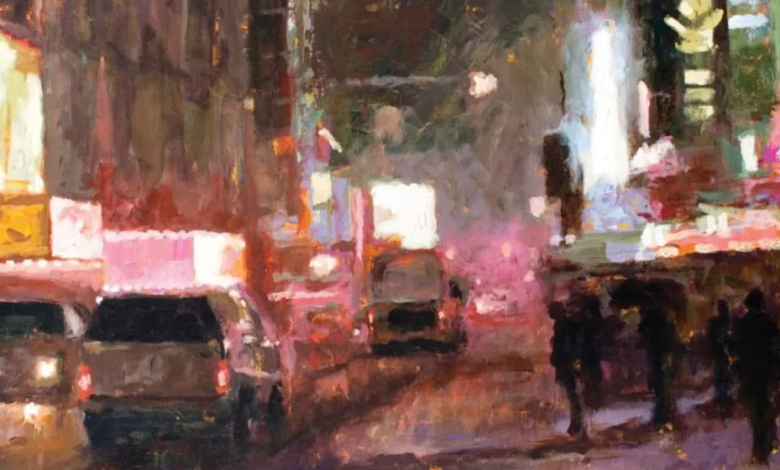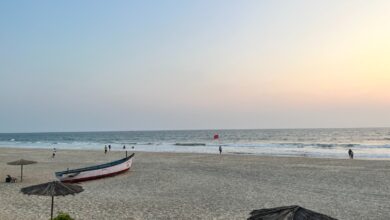Capturing the energy of the city with watercolors

Capturing the energy of the city with watercolors. Although he paints in a wide range of genres, including figures, flowers, and abstracts, John K. Harrell’s focus throughout his career has been on urban landscapes. When I started painting professionally, a friend let me see her vacation photos. I had a rainy scene in Paris, and the reflections and the architecture captivated me. Since then, I have been making pieces like that. They have evolved: at first, I didn’t paint cars or buses, and now I love at first to paint them.
Stormy weather
A particular type of urban scene attracts Harrell. His paintings offer direct views of busy streets and crowded pedestrian squares, compositions that place the viewer at the center of the action. This view provides a strong understanding of an occupied and fleeting moment. The weather too. In several of the artist’s portraits, such as Companions and Destiny, below, it is raining, on to rain, or has just finished raining. Between time and composition, we are devoured by these glimpses of the city. Our eyes blink at its bright signals and colored lights, as well as approaching buses and pedestrians. If we look too long, we may feel the need to move.
Love, light, action
The professional works principally with acrylic, painting from photographs, and hardly works outdoors with pastel. Half the fun is going out with my camera and taking as many digital photos as possible. I am quite faithful to what I am living at the moment. When I talk about online clothing Australia ladies from my photos, I seek to recreate the spirit and essence of what made my eye in the first place. I could change things here and there and leave out the details, but that actual moment is very important to me. It is the light that first captures Harrell’s interest in a scene. The first thing that strikes me is the light, whether it’s high-contrast or atmospheric, he says. Harrell is also amused when the weather or unforeseen circumstances enter the scene. Rain and fog add colorful reflections and a strong vibe to a view, which the artist paints with gusto.
Harrell prefers broad, broad brush strokes, which he applies primarily with a palette knife. Some paintings, including Misty Way, below, are completely painted without brushes. He uses a thick coat of paint, which results in highly textured surfaces. It can make his paintings lean towards the abstract, and the artist plans to take his work further in this direction. The more you lose, the better. I want viewers to identify some image in the painting and wonder how it happened, so loose that you don’t fully understand it.
Harrell has reassuring news for writers whose paintings don’t work. If he doesn’t feel good, he tells him, think about what he has already painted as a background paint. It removes the stigma that a painting has to be perfect every step of the way. Harrell prepares his students to review errors and warns them that it’s okay if arts don’t look good in the central boards. The most important part of my workshops is getting people to overcome their fear of using acrylic. Once they understand that they can enhance the fun, they love it.
Paint the glow of the city

In this display, Harrell explains his motivation and method for his vibrant, almost ideal art, City Glow. His signature thick-layered painting and dramatic color capture the speed and intensity of a New York City moment.
STEP 1
I fell in love with this image; It had everything I liked: lighting, atmosphere. The image represents the reason why I paint urban scenes. I used Golden Artist acrylics on acrylic primed cotton duck canvas, and then a putty knife was my main tool for applying paint. I began by toning the shade with a band of Indian yellow. Then I drew the horizontal and vertical center lines on both the canvas and the reference photo as a sketch guide. Next, I pulled the basic elements of the piece to establish the perspective and the large shapes of the painting.
STEP 2
I worked from background to foreground and from top to bottom. I started applying the first coat of color. My goal was to get closer to each area’s final color and value, but at this point, neither the color nor the matter had to be exact. I used a lot of paint, which added texture to the canvas.
STEP 3
The entire canvas was covered in color at this stage, except for small spots where the background paint was visible. I tried to keep it loose and spread it in a dense shade that would dry out to add another layer on top. I gave myself some valuable landmarks like the blank of the poster and the darkness of the car.
STEP 4
I concentrated on designing the shapes, refining the values, and defining the focal area. I also started to put the more intense color. At this point, he had a clear map of what he had to do to finish the piece. It was about vivid colors, strong values, and sharper or softer lines where needed.
STEP 5
For me, the ending is the best part. I sit down and put a little more color here, bring the painting to life there or dominate it here. It is taking the best elements of the painting and drilling them a little. I trust my intuition to lead me to the final piece. I know that the painting is finished. Painting City Glow after completion further intensified the color.
Also Watch: Educational Videos




